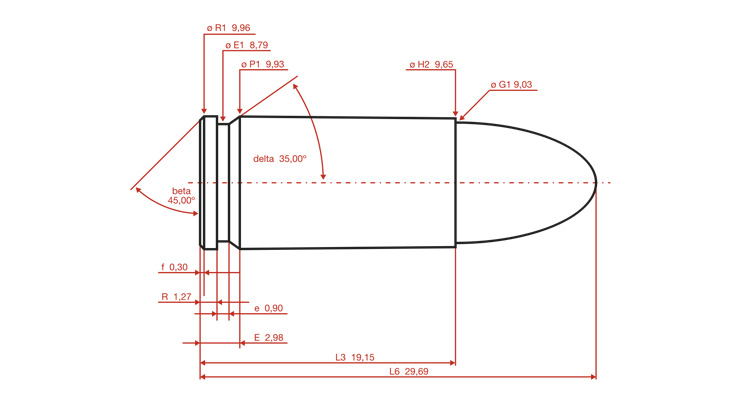
If you were look back at the first year of Calibre's Calibre, a trend would quickly become apparent. If you guessed the unintentional exclusivity of rifle cartridges, that would be a good (but incorrect) guess. Save some minor exceptions in the .22 LR and the .50 BMG, each of the cartridges featured was of the tried and true variety, originated as a military cartridge, and entered the civilian market with relative inexpensive - widespread availability. Such qualities leave little doubt as to why these rounds enjoy their commercial success, ever present on the local shop's shelves or punched out by do it yourself re-loaders coast to coast to coast. So how do we kick of our second volume of Calibre's Calibre? We bring you another cartridge that has all the elements of the aforementioned, only this one isn't a rifle cartridge - even if you can buy rifles which fire it.
We speak of the 9 x 19mm Parabellum. Otherwise known as the 9mm Luger, or just 9mm (among a many other). It was originally designed in 1901 by German arms designer, Georg Luger, as an evolution of Luger's previous 7.65 x 21mm Parabellum cartridge, otherwise known as the .30 Luger. Luger got his start in arms designs long before this, working under the wing of Hugo Borchardt and was very involved in the creation of the 7.65 x 25mm Borchardt, for which the classic C-93 pistol was chambered. Now employed by German arms maker, Deutsche Waffen und Munitionfabriken (DWM), Luger set off in 1902 to showcase his new design all over the globe. Interestingly, it was from DWM that the Parabellum moniker was associated to the 9mm. The company adopted the motto of, 'Si vis pacem, para bellum', which is a Latin adage meaning 'if you want peace, prepare for war'. A similar thought process saw the Colt Single Action Army handgun acquired its nickname, the Peacemaker.
As for the 9mm, it didn't take long to catch on. Many arms manufacturers - particularly in Germany, the United States, and the United Kingdom took notice, even if widespread use of 9mm chambered weapons would be delayed by the Great War. Even so, 1908 saw Luger introduce the world to the infamous Pistole Parabellum 08, or P08 for short, which was chambered in the 9mm and .30 Luger. The P08 became a prized possession for Allied soldiers during the wars and was arguably the first 9mm firearm to gain notoriety, with even the Germans becoming aware of such and known to use a P08 as bait in a booby trap. This desire to snag a P08 is almost cliche in many films about the Second World War. This was where the 'lucky' recipient often befell bad luck, shooting themselves with the pistol after going on about it earlier in the film.
But while the trench warfare may have impeded the 9mm at first, the evolution of trench raiding and the effectiveness of of sub-machine guns became noteworthy. Designs of such firearms exploded during and thereafter, many of which being chambered in the 9mm for use by national armed forces and law enforcement agencies. It steadily became the most popular calibre in American law enforcement agencies, which explains why the 9mm sees such a large following in North America. With most agencies using six round cylinder revolvers when it appeared, of which many being Smith & Wessen .38 Specials; the advantages of semi-automatic pistols were obvious in two regards. Faster reloads and larger capacity mags meant more shots fired in between. By the 1980's, the revolver was practically a thing of the past in the law enforcement world, though it should be noted the RCMP would wait some time before doing the same with their Smith & Wessen 5946.
Now some 109 years after its creation, the 9mm is in service in over 70 nations world wide, both in law enforcement and military applications. It is arguably is the basis for which other 9mm pistol cartridge designs were created, such as the .380 ACP and 9 x 18 mm Makarov. As a result, incomprehensible numbers of pistols and sub machine guns are chambered in several variations of 9mm, which guarantees global availability and a large commercial output. But it isn't just the widespread availability of firearms and ammunition which makes the 9mm a popular round. Its ballistics are admirable, sporting a flat trajectory over its originally intended effective range of 50m – though well established to be effective well beyond that mark, especially in modern variants. Adding in a moderate recoil, it allows shooters to quickly put several rounds on target in wake its apparent lack of stopping power in comparison to other pistol calibres.
But as the 9mm Parabellum goes - it is without question the most popular handgun and sub machine gun cartridge in the world and looks to remain so for the foreseeable future. It's easy to see why. Boasting manageable recoil, solid ballistics, affordability, and availability - it's the benchmark which others are always compared.